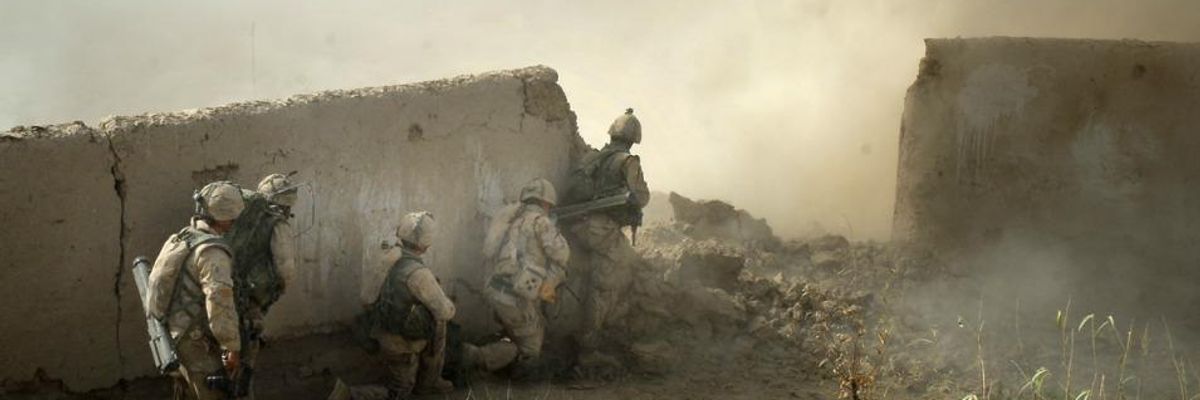
The United States' indefinite occupation of Afghanistan has now left the Taliban in control of more territory than in 2014. (Photo: QOR Museum/Flickr/cc)
Damning New Study Helps Explain Why Pentagon Will No Longer Release Afghan War Updates
It's the longest war in U.S. history, but it appears the military no longer wants the world to see how badly it's going
As the Pentagon is rebuked for withholding from the public information about the U.S. military's activities in Afghanistan, new reporting reveals that--more 16 years after the U.S. began its occupation--the Taliban has open and active presence in about 70 percent of the country, and ISIS has gained more territory than ever before.
On Tuesday, the Special Inspector General for Afghanistan Reconstruction (SIGAR) criticized the Department of Defense for refusing to release data on several Afghan districts, after the Pentagon determined it was "not releasable to the public":
The number of districts controlled or influenced by the Afghan government had been one of the last remaining publicly available indicators for members of Congress...and for the American public of how the 16-year-long U.S. effort to secure Afghanistan is faring. Historically, the number of districts controlled or influenced by the government has been falling since SIGAR began reporting on it, while the number controlled or influenced by the insurgents has been rising--a fact that should cause even more concern about its disappearance from public disclosure and discussion.
While the Afghan government asserts that it controls most of the country, the BBC reported Wednesday, "Months of research across the country shows that the Taliban now control or threaten much more territory than when foreign combat troops left in 2014."
According to SIGAR's last report, released in October, the Taliban only controlled about 40 percent of Afghan districts just last July.
About 15 million Afghans, or half of the country, now live in areas controlled by the Taliban or at risk of Taliban control. In parts of the country where the group is most open and active, attacks now take place about twice a week.
More than 31,000 civilians have been killed in Afghanistan since American troops arrived in October 2001, with more than 8,500 injured or killed in 2017. Twenty-four hundred American troops and hundreds of foreign soldiers have also been killed since the war began.
The BBC report also follows several recent attacks claimed by Taliban fighters and ISIS, the most recent being a bombing carried out by an ambulance that was driven into the center of Kabul last Saturday. At least 122 civilians have been killed in attacks over the past several weeks.
Last August, President Donald Trump announced that U.S. troops would remain in Afghanistan indefinitely, and on Monday, contradicting his previous claims, he rejected peace talks with the Taliban.
An Urgent Message From Our Co-Founder
Dear Common Dreams reader, The U.S. is on a fast track to authoritarianism like nothing I've ever seen. Meanwhile, corporate news outlets are utterly capitulating to Trump, twisting their coverage to avoid drawing his ire while lining up to stuff cash in his pockets. That's why I believe that Common Dreams is doing the best and most consequential reporting that we've ever done. Our small but mighty team is a progressive reporting powerhouse, covering the news every day that the corporate media never will. Our mission has always been simple: To inform. To inspire. And to ignite change for the common good. Now here's the key piece that I want all our readers to understand: None of this would be possible without your financial support. That's not just some fundraising cliche. It's the absolute and literal truth. We don't accept corporate advertising and never will. We don't have a paywall because we don't think people should be blocked from critical news based on their ability to pay. Everything we do is funded by the donations of readers like you. Will you donate now to help power the nonprofit, independent reporting of Common Dreams? Thank you for being a vital member of our community. Together, we can keep independent journalism alive when it’s needed most. - Craig Brown, Co-founder |
As the Pentagon is rebuked for withholding from the public information about the U.S. military's activities in Afghanistan, new reporting reveals that--more 16 years after the U.S. began its occupation--the Taliban has open and active presence in about 70 percent of the country, and ISIS has gained more territory than ever before.
On Tuesday, the Special Inspector General for Afghanistan Reconstruction (SIGAR) criticized the Department of Defense for refusing to release data on several Afghan districts, after the Pentagon determined it was "not releasable to the public":
The number of districts controlled or influenced by the Afghan government had been one of the last remaining publicly available indicators for members of Congress...and for the American public of how the 16-year-long U.S. effort to secure Afghanistan is faring. Historically, the number of districts controlled or influenced by the government has been falling since SIGAR began reporting on it, while the number controlled or influenced by the insurgents has been rising--a fact that should cause even more concern about its disappearance from public disclosure and discussion.
While the Afghan government asserts that it controls most of the country, the BBC reported Wednesday, "Months of research across the country shows that the Taliban now control or threaten much more territory than when foreign combat troops left in 2014."
According to SIGAR's last report, released in October, the Taliban only controlled about 40 percent of Afghan districts just last July.
About 15 million Afghans, or half of the country, now live in areas controlled by the Taliban or at risk of Taliban control. In parts of the country where the group is most open and active, attacks now take place about twice a week.
More than 31,000 civilians have been killed in Afghanistan since American troops arrived in October 2001, with more than 8,500 injured or killed in 2017. Twenty-four hundred American troops and hundreds of foreign soldiers have also been killed since the war began.
The BBC report also follows several recent attacks claimed by Taliban fighters and ISIS, the most recent being a bombing carried out by an ambulance that was driven into the center of Kabul last Saturday. At least 122 civilians have been killed in attacks over the past several weeks.
Last August, President Donald Trump announced that U.S. troops would remain in Afghanistan indefinitely, and on Monday, contradicting his previous claims, he rejected peace talks with the Taliban.
As the Pentagon is rebuked for withholding from the public information about the U.S. military's activities in Afghanistan, new reporting reveals that--more 16 years after the U.S. began its occupation--the Taliban has open and active presence in about 70 percent of the country, and ISIS has gained more territory than ever before.
On Tuesday, the Special Inspector General for Afghanistan Reconstruction (SIGAR) criticized the Department of Defense for refusing to release data on several Afghan districts, after the Pentagon determined it was "not releasable to the public":
The number of districts controlled or influenced by the Afghan government had been one of the last remaining publicly available indicators for members of Congress...and for the American public of how the 16-year-long U.S. effort to secure Afghanistan is faring. Historically, the number of districts controlled or influenced by the government has been falling since SIGAR began reporting on it, while the number controlled or influenced by the insurgents has been rising--a fact that should cause even more concern about its disappearance from public disclosure and discussion.
While the Afghan government asserts that it controls most of the country, the BBC reported Wednesday, "Months of research across the country shows that the Taliban now control or threaten much more territory than when foreign combat troops left in 2014."
According to SIGAR's last report, released in October, the Taliban only controlled about 40 percent of Afghan districts just last July.
About 15 million Afghans, or half of the country, now live in areas controlled by the Taliban or at risk of Taliban control. In parts of the country where the group is most open and active, attacks now take place about twice a week.
More than 31,000 civilians have been killed in Afghanistan since American troops arrived in October 2001, with more than 8,500 injured or killed in 2017. Twenty-four hundred American troops and hundreds of foreign soldiers have also been killed since the war began.
The BBC report also follows several recent attacks claimed by Taliban fighters and ISIS, the most recent being a bombing carried out by an ambulance that was driven into the center of Kabul last Saturday. At least 122 civilians have been killed in attacks over the past several weeks.
Last August, President Donald Trump announced that U.S. troops would remain in Afghanistan indefinitely, and on Monday, contradicting his previous claims, he rejected peace talks with the Taliban.

